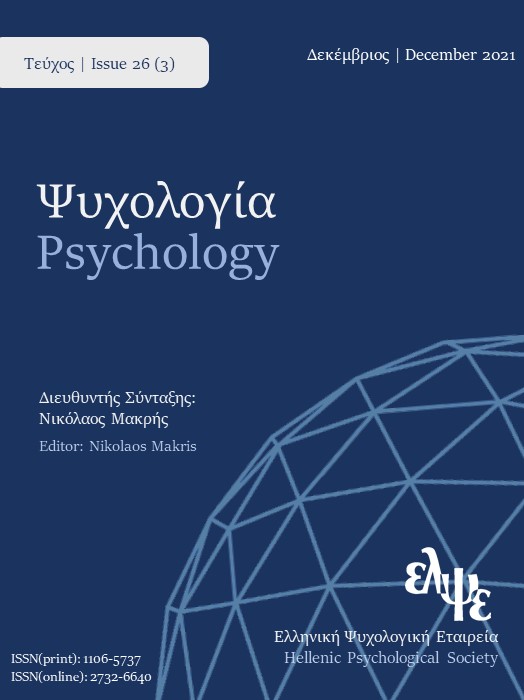Μελέτη της σχέσης φωνολογικής επίγνωσης και αναγνωστικής ικανότητας μέσω της καταγραφής Γνωστικών Προκλητών Δυναμικών

Περίληψη
Η παρούσα έρευνα εξέτασε τις διαφορές μεταξύ παιδιών με αναγνωστικές δυσκολίες (ΑΔ) και τυπικών αναγνωστών (ΤΑ) (με ηλικιακό εύρος 7,70 μέχρι 12,08 χρονών· Μ.Ο. = 9,79, Τ.Α. = 1,57· Κορίτσια = 24) σε δύο έργα φωνολογικής επίγνωσης (αφαίρεση φωνήματος και παραδρομή της γλώσσας), μέσω της καταγραφής Γνωστικών Προκλητών Δυναμικών. Από την καταγραφή των ηλεκτροεγκεφαλογραφημάτων παρατηρήθηκε η έκλυση της κυματομορφής Ν400. Τα αποτελέσματα για την ηλικιακή ομάδα των 8 ετών έδειξαν ότι οι συμμετέχοντες με ΑΔ είχαν εκτενέστερο Ν400 σε σχέση με τους ΤΑ στο έργο αφαίρεσης φωνήματος, εύρημα που φανερώνει μεγαλύτερη προσπάθεια, εκ μέρους των παιδιών με ΑΔ, για την επεξεργασία φωνολογικών ερεθισμάτων συγκριτικά με τους τυπικά αναπτυσσόμενους συνομηλίκους τους. Τα χαρακτηριστικά της κυματομορφής Ν400 στο έργο αφαίρεσης αρχικού φωνήματος ήταν παρόμοια μεταξύ των συμμετεχόντων με ΑΔ και των ΤΑ που ανήκαν στην ηλικιακή ομάδα των 11 ετών, καταδεικνύοντας ότι οι δυσκολίες που αντιμετωπίζουν τα παιδιά στα έργα φωνολογικής επίγνωσης μετριάζονται με την ανάπτυξη, λόγω του βαθμού διαφάνειας του ελληνικού ορθογραφικού συστήματος. Στο έργο παραδρομής της γλώσσας, οι διαφορές μεταξύ των ομάδων στην κυματομορφή Ν400 δεν ήταν στατιστικά σημαντικές, πιθανότατα λόγω του αυξημένου βαθμού δυσκολίας του συγκεκριμένου έργου. Η συζήτηση εστιάζεται στη σημασία της καταγραφής των Γνωστικών Προκλητών Δυναμικών ως μίας τεχνικής που μπορεί να προσφέρει σημαντική πληροφόρηση αναφορικά με τους φωνολογικούς μηχανισμούς που υποστηρίζουν την ανάγνωση.
Λεπτομέρειες άρθρου
- Πώς να δημιουργήσετε Αναφορές
-
Φέλλα Α., Χριστοφόρου Χ., Λοϊζου-Παπαδοπούλου Μ., & Παπαδόπουλος Τ. Κ. (2022). Μελέτη της σχέσης φωνολογικής επίγνωσης και αναγνωστικής ικανότητας μέσω της καταγραφής Γνωστικών Προκλητών Δυναμικών. Ψυχολογία: το περιοδικό της Ελληνικής Ψυχολογικής Εταιρείας, 27(3), 79–97. https://doi.org/10.12681/psy_hps.28820
- Ενότητα
- ΕΜΠΕΙΡΙΚΕΣ ΕΡΓΑΣΙΕΣ

Αυτή η εργασία είναι αδειοδοτημένη υπό το Creative Commons Attribution-ShareAlike 4.0 International License.
Το περιοδικό ΨΥΧΟΛΟΓΙΑ έχει υιοθετήσει μία πολιτική Platinum open-access. Τα έξοδα υποβολής, επεξεργασίας ή δημοσίευσης των εργασιών καλύπτονται από την Ελληνική Ψυχολογική Εταιρεία. Τα πνευματικά δικαιώματα των δημοσιευμένων εργασιών προστατεύονται από την άδεια 'Creative Commons Attribution-ShareAlike 4.0 International'. Οι Συγγραφείς διατηρούν τα Πνευματικά Δικαιώματα και χορηγούν στο περιοδικό το δικαίωμα της πρώτης δημοσίευσης. Η άδεια αυτή επιτρέπει σε τρίτους, να χρησιμοποιούν την εργασία σε οποιαδήποτε μορφή, με την προϋπόθεση της διατήρησης των διατυπώσεων που προβλέπονται στην άδεια σχετικά με την αναφορά στον αρχικό δημιουργό και την αρχική δημοσίευση στο περιοδικό ΨΥΧΟΛΟΓΙΑ. Επιπλέον, κάθε διανομή της εργασίας οφείλει να γίνεται με τους ίδιους όρους διανομής, δηλαδή με την ίδια άδεια Creative Commons.




